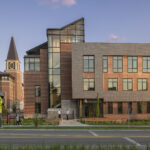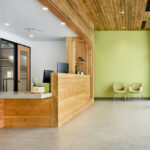Research
Results from Phase 2 Blast Tests of Full-Scale CLT Structures
TR-18-06.2
UFC 4-010-01 requires that inhabited Department of Defense buildings constructed of mass timber structural systems be analyzed for blast loads. As of the summer of 2015, there was a lack of test data documenting mass timber system response under the strain rates imposed by blast loads, particularly of cross-laminated timber (CLT) systems. To address this knowledge gap, a series of quasi-static laboratory and arena blast tests were performed on CLT panels and structures without axial load. In Phase 1 of these tests, three different CLT grades (i.e., V1, E1, and V4) were investigated.
This report summarizes a series of Phase 2 tests that were subsequently performed based on the Phase 1 results.
The overarching objectives were to investigate:
- The response of axially-loaded CLT construction exposed to blast loads; and
- The response of alternative (from those tested in Phase 1) mass timber panel and connection configurations exposed to blast loads.
Toward this end, two distinct series of tests were performed as part of the Phase 2 effort:
- A total of twenty-four quasi-static laboratory tests were used to investigate the flatwise bending response of axially-loaded CLT panels in their major strength direction under a uniformly-applied transverse quasi-static load. These tests varied the applied axial load, CLT grade, number of panel plies, and panel length, and were performed using the Air Force Civil Engineer Center’s load tree testing apparatus.
- Four arena blast tests (in addition to the three tests performed in Phase 1) were performed on three existing full-scale CLT structures constructed at Tyndall Air Force Base. The first two tests were used to demonstrate the ability of axially-loaded CLT panels to resist blast loads while the second two tests were used to demonstrate the ability of alternative mass timber configurations (i.e., 5-ply panels, alternative connection types, nail-laminated timber) to resist blast loads. In both test series, the first shot was intended to keep the panels elastic and the second shot was intended to rupture panels. Ruptured panels were removed and replaced prior to performing the first test in each series.



